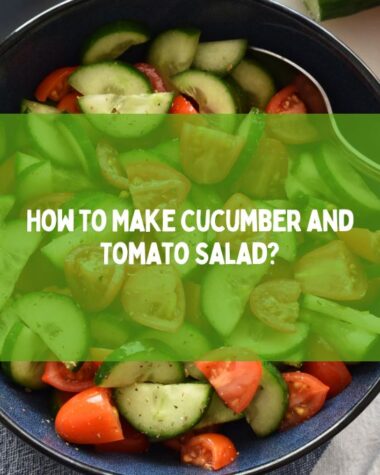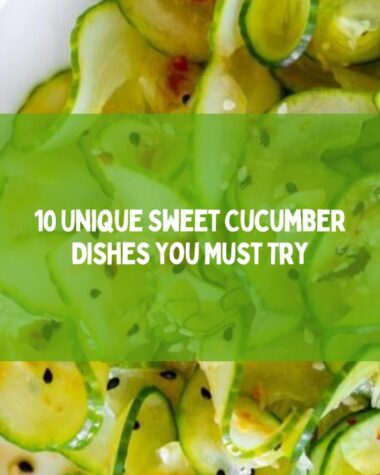Are you craving a light and refreshing dish that will awaken your taste buds? Look no further than Asian Cucumber Salad! Bursting with flavors and textures, this salad is a perfect balance of sweet, tangy, and savory.
This article will explore the fascinating world of Asian cucumber salad, learn how to make it, and uncover some interesting variations.
Get ready to tantalize your palate with this culinary delight!
What is Asian Cucumber Salad?
Asian cucumber salad is a vibrant and refreshing dish that hails from the rich culinary traditions of Asia. This salad showcases the humble cucumber in all its glory, combining it with a medley of flavors to create a harmonious and satisfying taste experience.

The salad typically features thinly sliced or julienned cucumbers dressed in a tangy and aromatic sauce, often made with ingredients such as soy sauce, rice vinegar, sesame oil, ginger, and garlic.
Adding fresh herbs like cilantro, mint, or Thai basil adds a burst of freshness and enhances the overall appeal of the salad. With its crisp texture, bright flavors, and colorful presentation, Asian cucumber salad is a delightful addition to any meal or gathering.
How many calories are in Asian Cucumber Salad?
Asian Cucumber Salad per serving has 95 calories.
The Ingredients: Freshness is Key
To create the perfect Asian cucumber salad, it’s crucial to start with high-quality, fresh ingredients. Here are the main components that make up this delightful dish:
- Cucumbers: Crisp and juicy cucumbers are the star of this salad. Look for Asian cucumbers or English cucumbers, as they have a milder taste and fewer seeds compared to regular cucumbers.
- Asian Dressing: The dressing is what brings the salad to life. A classic Asian dressing typically includes soy sauce, rice vinegar, sesame oil, ginger, garlic, and a touch of sweetness from sugar or honey. This combination of flavors creates a harmonious blend that complements the cucumbers perfectly.
- Fresh Herbs: Fragrant herbs like cilantro, mint, and Thai basil add a burst of freshness to the salad. Their vibrant colors and aromatic profiles enhance the overall flavor and visual appeal.
- Optional Additions: While the core of Asian cucumber salad revolves around cucumbers, feel free to add your own creative twists. Some popular additions include sliced red onions, crushed peanuts, sesame seeds, or even a sprinkle of chili flakes for some heat.
Related Reading:
- Simple and Healthy Recipe for Lettuce, Cucumber, and Tomato Salad
- How to Make Cucumber and Tomato Salad?
- 10 Unique Sweet Cucumber Dishes You Must Try
- Sip Your Way to Good Health with Cucumber Lemon Water
- Refreshing Twist: The Ultimate Guide to the Cucumber Mint Margarita
How To Make Asian Cucumber Salad? A Step-by-Step Guide to Culinary Bliss

Creating your own Asian cucumber salad is a straightforward process that requires minimal effort. Let’s break it down into easy-to-follow steps:
Step 1: Gather the Ingredients
Before you begin, ensure you have all the necessary ingredients at hand. This will make the preparation process smooth and enjoyable. Take a moment to double-check your pantry and refrigerator for everything you need.
Step 2: Prepare the Cucumbers
Start by washing the cucumbers thoroughly under running water. If you prefer a milder taste, peel the cucumbers using a vegetable peeler. Once cleaned, slice the cucumbers into thin rounds or julienne them for a more elegant presentation. Place the prepared cucumbers in a large bowl.
Step 3: Prepare the Dressing
In a separate bowl, combine the soy sauce, rice vinegar, sesame oil, minced ginger, minced garlic, and a pinch of sugar or honey. Whisk the ingredients together until well incorporated. Taste the dressing and adjust the flavors to suit your preferences.
Step 4: Combine and Toss
Pour the dressing over the sliced cucumbers in a large bowl. Add the fresh herbs of your choice and any optional additions you desire. Gently toss the ingredients together until the cucumbers are evenly coated with the dressing and the herbs are well distributed.
Step 5: Chill and Serve
Cover the bowl with plastic wrap and place it in the refrigerator for at least 30 minutes to allow the flavors to meld together. When ready to serve, take the bowl out of the refrigerator, give the salad a final toss, and transfer it to a serving dish. Garnish with additional herbs, sesame seeds, or crushed peanuts for an extra touch of elegance.
Asian Cucumber Salad Variations: Exploring Flavors from East to West

While the classic Asian cucumber salad is undeniably delicious, there’s always room for experimentation. Here are a few exciting variations that you can try to add a unique twist to this already fabulous dish:
1. Japanese-Inspired Wasabi Cucumber Salad
For those who love a hint of heat, this Japanese-inspired variation takes the salad to a whole new level. Simply substitute the ginger in the dressing with wasabi paste, and you’ll have a refreshing and spicy cucumber salad that pairs perfectly with sushi or grilled fish.
2. Korean Kimchi Cucumber Salad
If you’re a fan of spicy and tangy flavors, this Korean-inspired variation is for you. Combine the cucumbers with kimchi, a traditional Korean fermented side dish, and add a splash of gochujang (Korean chili paste) to the dressing. The result is a fiery and addictive cucumber salad that will awaken your taste buds.
3. Thai Green Papaya Cucumber Salad
For a Southeast Asian twist, replace the cucumbers with green papaya. Shred the papaya using a julienne peeler or a grater and follow the same steps as the classic recipe. The combination of green papaya and cucumbers creates a refreshing and crunchy salad with a vibrant Thai flair.
4. Mediterranean Cucumber Salad
Take a detour from Asia and head to the Mediterranean with this variation. Combine cucumbers with cherry tomatoes, feta cheese, olives, and a drizzle of olive oil and lemon juice. Toss everything together and sprinkle with fresh dill or parsley. This fusion of flavors will transport you to the sunny shores of the Mediterranean.
Conclusion: A Journey of Flavors with Asian Cucumber Salad
Asian cucumber salad is a versatile and refreshing dish that transcends boundaries. Whether you stick to the classic recipe or explore adventurous flavors, this salad never fails to impress.
The crispness of the cucumbers, the tang of the dressing, and the freshness of the herbs come together to create a harmonious symphony of flavors.
So why wait? Grab your ingredients, follow our simple steps, and indulge in the delectable world of Asian cucumber salad.
Related Reading:
- Pumpkin Soup: A Comforting Delight for Autumn Nights
- Thomas Keller’s Oven-Roasted Zucchini: A Simple and Flavorful Side Dish
- What is the Best Way to Freeze Zucchini?
- What’s the Best Way to Cook Eggplant?
FAQs about Asian Cucumber Salad
Here are some FAQs about Asian cucumber salad.
Can I make an Asian cucumber salad in advance?
Absolutely! Asian cucumber salad tastes even better when prepared in advance. The flavors have time to meld together, resulting in a more vibrant and delicious salad.
How long does Asian cucumber salad last in the refrigerator?
When stored in an airtight container, Asian cucumber salad can last up to 2 days in the refrigerator. However, it’s best enjoyed within 24 hours to maintain the freshness of the ingredients.
Can I substitute regular cucumbers for Asian cucumbers?
While regular cucumbers can be used as a substitute, Asian cucumbers or English cucumbers are preferred for their milder taste and fewer seeds.
Is Asian cucumber salad gluten-free?
The salad itself is gluten-free, but make sure to check the labels of the ingredients you use, such as soy sauce, to ensure they are gluten-free.
Can I add protein to Asian cucumber salad to make it a complete meal?
Absolutely! Asian cucumber salad pairs well with grilled chicken, shrimp, tofu, or even edamame. Adding a protein source will turn it into a satisfying and nutritious meal.
Are there any variations for those with dietary restrictions?
Certainly! Asian cucumber salad can easily be customized to accommodate dietary restrictions. For a vegan version, use tamari or coconut aminos instead of soy sauce. To make it paleo-friendly, replace the sugar with a natural sweetener like maple syrup or coconut sugar.






